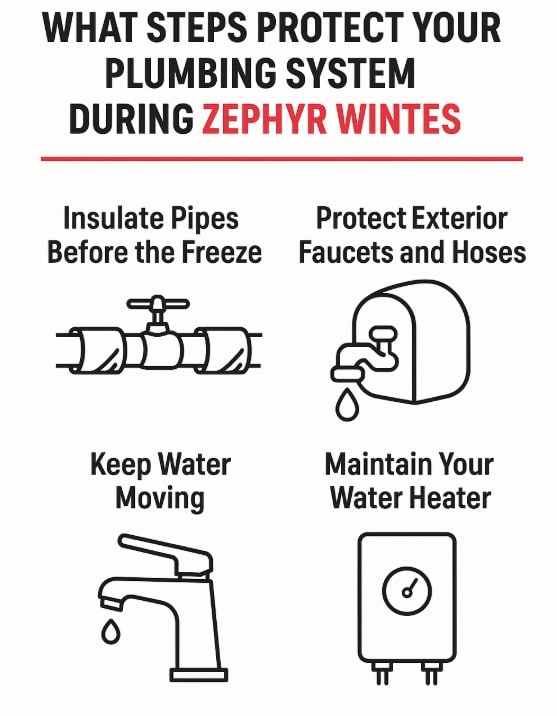What Steps Protect Your Plumbing System During Zephyr Winters
When the temperatures in Zephyr dip below freezing, homeowners face more than just frosty mornings. The real concern hides behind the walls and under the floors: your plumbing. Winter plumbing protection in Zephyr is not just a suggestion; it is a necessity. Without the right steps, pipes can freeze, burst, and cause thousands of dollars in damage. The good news is that with preparation and the right habits, you can avoid those emergencies and keep your home safe all season.
Why Winter Plumbing Protection in Zephyr Matters
Zephyr winters may not compare to northern blizzards, but Texas cold snaps can be sudden and severe. A single night of freezing weather is enough to put pipes at risk. Many homeowners assume that because the season is short, preparation is not necessary. Unfortunately, that assumption often ends with flooded kitchens or damaged water heaters. Cold-weather plumbing maintenance is like insurance: you only notice its value when you need it.
Common Risks During Freezing Temperatures
Understanding what can go wrong makes it easier to see why preparation is worth it. The most common winter plumbing issues in Zephyr include:
- Frozen pipes that expand and burst when the ice inside grows.
- Clogged drains occur when grease, soap, or food hardens faster in cold pipes.
- Overworked water heaters that break down from higher seasonal demand.
- Exterior faucets and irrigation lines that split because they are exposed to direct freezing air.
Each of these problems is preventable with careful winter plumbing protection in Zephyr.
Step One: Insulate Pipes Before the Freeze
The simplest step to prevent frozen pipes in Zephyr, TX, is insulation. Foam sleeves or wrap tape keep pipes from reaching freezing temperatures. Focus on:
- Attics
- Garages
- Crawl spaces
- Exterior walls
Even inexpensive insulation saves hundreds in potential repair costs. Think of it as a warm coat for your plumbing system.
Step Two: Protect Exterior Faucets and Hoses
Outdoor faucets are the first to freeze. To protect pipes in freezing temperatures:
- Disconnect garden hoses.
- Drain remaining water.
- Cover spigots with insulated faucet covers.
For irrigation systems, shut them down before the first freeze. Blow out water lines or call a professional if you are not sure how.
Step Three: Keep Water Moving
Water that keeps flowing is less likely to freeze. During extreme cold, let faucets drip slightly. This small trick relieves pressure in the line and prevents costly bursts. Homeowners in Zephyr often keep bathroom and kitchen cabinets open to let warm air reach pipes as well.
Step Four: Maintain Your Water Heater
Your water heater works hardest in winter. Sediment buildup and worn parts can cause sudden breakdowns. Routine inspection and flushing improve efficiency and extend lifespan. Many families forget this step until a cold shower reminds them. Scheduling seasonal maintenance ensures steady hot water when you need it most. Our services at On Point Plumber include thorough water heater inspections for peace of mind.
Step Five: Seal Drafts and Openings
Cold air sneaking into crawl spaces or attics drops temperatures quickly. Sealing cracks, vents, or gaps around pipes provides double protection: lower heating bills and safer plumbing. Expanding foam and caulk are inexpensive solutions you can handle in a weekend.
Step Six: Plan for Emergencies
Even with preparation, emergencies can happen. Keep the number of a trusted plumber saved in your phone. Know where your main shut-off valve is located. Shutting off the water quickly can reduce damage dramatically if a pipe bursts.
Winterize Plumbing System: A Practical Checklist
| Task | Why It Matters | When To Do It |
| Insulate exposed pipes | Prevent frozen pipes | Early fall |
| Drain hoses and cover spigots | Protect exterior lines | Before the first freeze |
| Flush water heater | Improve efficiency | Once yearly |
| Check for drafts | Stop freezing air | Early winter |
| Let faucets drip | Keep water moving | On freezing nights |
Quick Visual Guide: Winter Plumbing Protection in Zephyr
Here’s a simple infographic to keep these steps handy all season.
The Role of Professional Cold Weather Plumbing Maintenance
Some jobs are perfect for do-it-yourself. Others require trained hands. A professional plumber knows where hidden pipes run, how to test for weak spots, and what updates will give you long-term protection. OnPoint Plumber has helped Zephyr families prepare their homes for years. Homeowners often share stories of same-day visits where frozen pipes were saved before disaster struck. That type of timely service shows how preparation and quick action can make the difference.
Staying Ahead of Zephyr’s Weather Surprises
Texas weather is unpredictable. Warm one day, icy the next. Waiting until the freeze arrives puts your home at risk. The best approach is steady cold-weather plumbing maintenance all season. Each small step builds a shield against unexpected drops in temperature.
Ready to Protect Your Home This Winter?
Do not wait until freezing weather catches you off guard. A single call today can save you thousands in repairs tomorrow. Let the trusted experts at OnPoint Plumber inspect, insulate, and winterize your plumbing system before the next cold snap.
Schedule Your Winter Plumbing Checkup Now
FAQs
1. How do I prevent frozen pipes in Zephyr, TX?
Insulate exposed lines, keep faucets dripping on cold nights, and cover outdoor spigots.
2. Do I need to winterize my plumbing system every year?
Yes, yearly preparation ensures your home is protected during sudden Texas freezes.
3. Can I leave my outdoor hoses connected during winter?
No, hoses hold water that freezes and expands, leading to burst spigots.
4. At what temperature should I worry about my pipes freezing?
Pipes are at risk when outdoor temperatures fall to 32°F or below, especially overnight.
5. How often should I schedule cold-weather plumbing maintenance?
At least once a year, ideally in the fall before temperatures drop.

